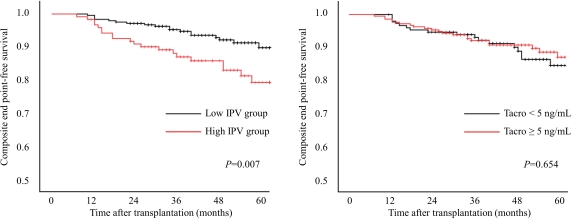The Effect of Tacrolimus Trough Level and Intrapatient Variability on the Transplant Outcomes in Kidney Transplantation
1Surgery, Yonsei University College of Medicine, Seoul, Korea
2Surgery, Ewha Womans University, School of Medicine, Seoul, Korea
3Surgery, CHA Bundang Medical Center, CHA University, Seongnam, Korea
4Internal Medicine (Nephrology), Yonsei University College of Medicine, Seoul, Korea.
Meeting: 2018 American Transplant Congress
Abstract number: C80
Keywords: Calcineurin, Kidney transplantation, Monitoring, Pharmacokinetics
Session Information
Session Name: Poster Session C: Kidney Immunosuppression: Novel Regimens and Drug Minimization
Session Type: Poster Session
Date: Monday, June 4, 2018
Session Time: 6:00pm-7:00pm
 Presentation Time: 6:00pm-7:00pm
Presentation Time: 6:00pm-7:00pm
Location: Hall 4EF
Background: Tacrolimus (TAC) is the mainstay of immunosuppression for kidney transplantation (KT). Although TAC has a narrow therapeutic index, appropriate trough concentrations of TAC have not been clearly defined to date.
Method: We analyzed patients underwent KT between 2011 and 2015 and treated with TAC-based triple immunosuppressant. Mean trough concentration and intrapatient variability (IPV) were calculated from the TAC concentrations between 6 and 12 months after KT. Patients were grouped according to mean TAC concentration (high TAC [≥5 ng/mL] vs. low TAC [<5 ng/mL]) and IPV (high IPV [upper tertile] vs. low IPV [lower two tertiles]).
Results: A total of 347 patients with a mean TAC concentration of 5.7 ± 2.0 ng/mL were included (143 low TAC and 204 high TAC groups). Mean TAC concentration was not different between high IPV and low IPV groups (5.8 ± 1.8 vs. 5.6 ± 2.3 ng/mL, P=0.39). The composite end point consisting of graft loss and allograft rejection 1 year after transplant was associated with high IPV rather than mean TAC concentration. After adjustment for delayed graft function, diabetes, and age, high IPV remained a significant risk factor for the composite end point (hazard ratio: 2.06, 95% CI: 1.08-3.94, P<0.028). High IPV group had significantly worse glomerular filtrate rate at 1, 2, and 3 years post-transplant.
Conclusion: This suggests that high IPV rather than mean concentration is related to worse outcomes in KT.
CITATION INFORMATION: Lee J., Lee J., Jung Y., Kim D., Song S., Lee J., Lee J., Kim M., Kim S., Kim Y., Kim B., Huh K. The Effect of Tacrolimus Trough Level and Intrapatient Variability on the Transplant Outcomes in Kidney Transplantation Am J Transplant. 2017;17 (suppl 3).
To cite this abstract in AMA style:
Lee J, Lee J, Jung Y, Kim D, Song S, Lee J, Lee J, Kim M, Kim S, Kim Y, Kim B, Huh K. The Effect of Tacrolimus Trough Level and Intrapatient Variability on the Transplant Outcomes in Kidney Transplantation [abstract]. https://atcmeetingabstracts.com/abstract/the-effect-of-tacrolimus-trough-level-and-intrapatient-variability-on-the-transplant-outcomes-in-kidney-transplantation/. Accessed January 6, 2026.« Back to 2018 American Transplant Congress


